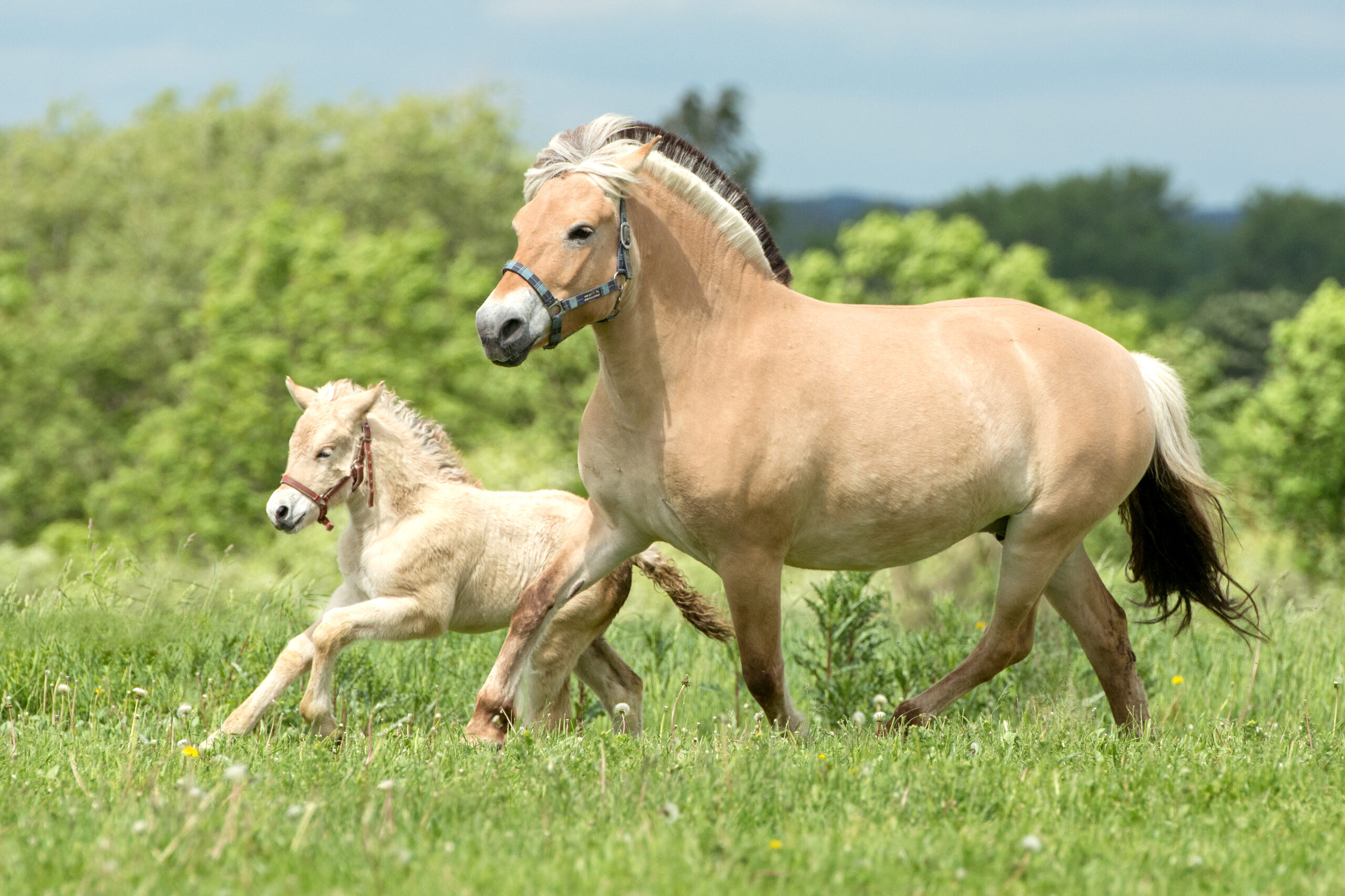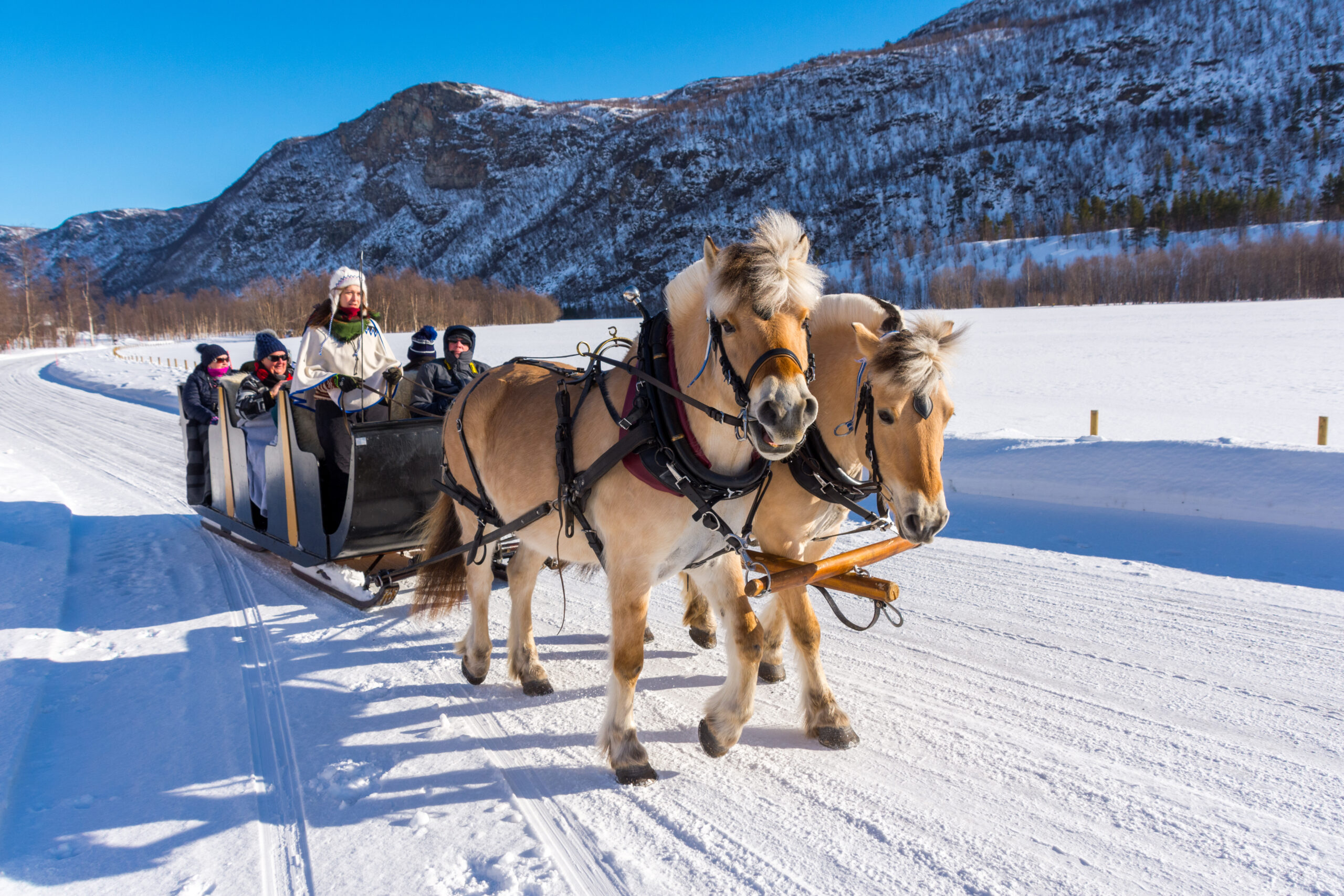The stocky Fjord Horse is the indigenous breed of Norway. No one is quite sure how long they have existed in this land, though some experts say it may be 4,000 years. Some of Fjord Horses’ unusual features are remarkably similar to ancient horses depicted in cave paintings. What is known is that Fjord Horses are some of the toughest and most useful horses for rugged environments. Surefooted and steady, they were used on farms along Norway’s remote mountainous western coastline. History tells us that there were few people hardier than the Vikings, and the same is true of their horses!
History and Origins
The origins of the Fjord Horse are obscure, though some suggest they were a wild population that migrated to this region. What is known is that for centuries, they have been the mainstays of remote farms in Norway’s Western Fjord region. With their great powers of strength and endurance, the Fjords were used as pack and draft animals as well as for riding. They may even have been used as warhorses by Viking warriors.
An interesting aspect of Norse culture is that they used horses for plowing rather than the oxen that were used throughout Europe in medieval times. This has led to a theory that the Fjord Horses are the ancestors of all modern draft horse breeds. These horses developed into a distinctive type with a light coat color and dorsal stripe. Their phenotype – that is, body shape, with an upright mane – is very similar to that of the Przewalski Horse. Researchers have now shown that the Przewalski Horses, rather than being the remaining wild horses in the world, are in fact the feral remnants of an originally domesticated population.
This suggests that the Fjord Horses may well also represent the descendants of an ancient domestication event, as researchers have long argued. Until the nineteenth century, the Fjord Horses were smaller than they are today, and various coat colors were known. Today, the horses are exclusively dun and cream. Prior to the establishment of the breed standard in the 1880s, Fjords could be brown, bay, and other colors. Now, their coats are almost exclusively dun and cream in five variations.
After attempts were made to alter the nature of the horses using Dole stallions, the original type was nearly lost. By 1891, only one single traditional stallion, Njal 166, survived. All modern Fjord Horses are descendants of this stallion. The stud book was established in 1910. Fjords played a part in WWII as pack horses in remote parts of Norway during the conflict. Breed enthusiasts now exist throughout the world. The dedicated horse registry is maintained by The Norwegian Fjord Horse Association (NFHR).
Can you ride a Fjord Horse?
Yes, you can. Fjord Horses are reliable and surefooted riding horses.
Norwegian Fjord horses – Conformation
Fjords generally stand between 13 hands (52 inches/132 cm) and 14.1 hands (57 inches/145 cm) high. There is no upper height limit, but the breeding of over-height individuals is not encouraged. They are stocky and strong, with powerful crested necks. Their weight is between 880 lb (400 kg) and 1,100 lb (500 kg). Their heads are neat and alert.
Manes can grow long and break over the neck. However, it is traditional to trim them so that they are about two inches (5 cm) to four inches (10 cm) long. Trimming the mane brings out the distinctive black line that is an extension of the dorsal stripe, a notable feature of their appearance. It seems this was a popular way of presenting the horses in the days of the Vikings. Norse warriors were very conscious of their own appearance and enhanced it in many different ways.
Cutting the manes may have made the horses seem even stronger, and perhaps fiercer. It also served a practical purpose, especially when the horses were used for farm and pack work. The dark stripe in the mane is known as the midtstol. In the tail, it is called halefjær. Zebra-type stripes on the legs also occur, varying in darkness according to the coat color. These distinctive markings are sometimes called “primitive markings.”
In winter, their coat grows thick and dense to protect them from the Norwegian weather, which can be either wet and cold or freezing and snowy! White markings on the face or legs are not encouraged in registered animals. They can have a small amount of feathering but it should not be

Fjords generally stand between 13 hands (52 inches/132 cm) and 14.1 hands (57 inches/145 cm) high. Their weight is between 880 lb (400 kg) and 1,100 lb (500 kg).
Fjord Horse: Variations on a Theme of Dun
It’s a truism to say that all Fjords are dun. However, within that coloring, there can be many beautiful shades and variations. Five are recognized within the breed standard:
- The first of these is Brunblakk, and it is also the variant seen most frequently. This is a variety of yellowy-brown, shading towards cream. The distinctive dorsal stripe and its extensions into the mane and tail are dark-brown or even black.
- Rødblakk is a yellow-red coat color, with a dorsal stripe and its extensions being a darker red-brown. The mane and tail vary and are very light-colored.
- Grå suggests gray, and that is its literal meaning. However, it is, in fact, technically the result of a black base coat influenced by cream and dun dilution genes. This produces lovely shades between silvery and slate-colored. Dorsal stripe, midtstol, and halefjær are generally lighter than the body color.
- Ulsblakk, sometimes called white dun, results from cream and dun dilution genes together. This produces a cream-colored coat with a light mane and tail. The midstol, halefjær, and dorsal stripe are dark gray or black. Once, most registered Fjords were this color.
- Gulblakk is also known as yellow dun and occasionally palomino dun. This is the effect of cream and dun dilution genes on a red base coat color, resulting in cream with a lighter mane and tail. Dorsal, mane, and tail stripes are usually a pale golden color.
As well as the five basic dun coat variations, the rare color Kvit (white) occurs but was historically not encouraged. It results from the influence of two cream dilution genes, inherited via the mare and stallion, on any base coat color. The coat is pale cream and the eyes are blue. Essentially, it is a cremello or perlino variation.
Video of Fjord horse
Characteristics of the Fjord Horse
They are sure-footed, hardy, and extremely strong. Friendly, curious, and sensible, they are great partners in any adventure. They may be small, but they are strong enough to carry small adult riders. Interestingly the global population of Fjords is higher outside Norway than in its own country. There are believed to be about 5,500 Fjords in Norway currently. They are very proud of their gorgeous Fjord Horses, though, and the animals appear on the coats of arms of Nordfjord – Gloppen, and Eid. Fjords can also be very long-lived horses.
How much does a Fjord Horse cost?
You can expect to pay between $3000 and $10,000 for a Fjord Horse, depending on age and experience.
Breeding and Uses
Sometimes described as “mini-drafts,” some Fjord Horses are still performing their traditional role on some farms and smallholdings. Increasingly they are used in every type of equestrian competition from dressage to long distance. Being curious, intelligent animals, they can adapt to all kinds of work. Traditionally, they were also driven in a cajol, a two-seater vehicle in which the seats are one behind another. They are used in riding schools and trekking centers, and increasingly, as therapy horses.

Despite their smaller size, Fjord horses are strong horses and very robust.
Diet and Nutrition
This breed is extremely easy to keep. They originated in a mountainous area without lush grazing, and have developed the mechanisms to withstand cold weather. They need short, unfertilized grass and, in winter, some hay that is not too rich. They are unlikely to need additional feed unless they are in very demanding work. Some of the Fjords taking part in distance riding are likely to need additional feed.
Health and Behavior of Fjord Horses
Fjords are generally very healthy animals, but on too rich a diet, they may risk colic and founder. They are temperamentally very sensible, well-balanced animals who enjoy the company of humans. Steadiness rather than speed is their forte. They make good all-around family horses.
Are Fjord Horses good for beginners?
Yes, many Fjord Horses make great beginners’ horses, especially for people who love their unique and independent characters. They are easy to keep, small enough for children to ride, and strong enough to carry adults, too.

